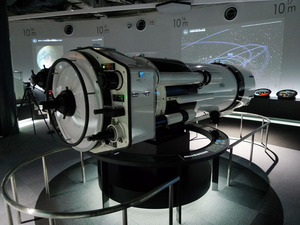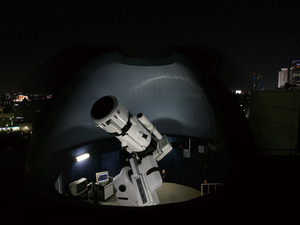Nagoya City Science Museum
TOP > Exhibition Guide > Keyword Search > Starting with "T" > telescope > 65cm Reflecting Telescope
65cm Reflecting Telescope



Purpose of Exhibition
This 65cm reflecting telescope had been installed at the rooftop observatory in the former Science and Technology Building in March 1986.
The performance of a telescope is based on its aperture of the primary mirror, and 65cm was the largest among contemporary telescopes for public viewing. The telescope was placed at the central area of Nagoya City for convenience of citizens. Then, the inner surface of the lens barrel is coated with special black paint so that it is as unaffected by the city lights as possible, and besides, many doughnut-shaped plates are inserted to prevent stray light (diffused light inside).
Additional Knowledge
How do telescopes help us see into space?
[Light-Gathering Power and Magnification of a Telescope]
Stars and celestial bodies in the night sky are darker than daytime landscape. Etymologically the word “telescope” means “far-seeing,” and indeed telescopes are used to see distant views during sufficiently bright daytime, but the most important and fundamental feature of the astronomical telescope is light-gathering power, not far-seeing. The term “Light Gathering Power” refers to the light collecting ability of a telescope, and is proportional to the light-collecting area of its primary lens or mirror.
The 65cm telescope can collect 10,000 times more light than the naked eye. While the pupil in dark conditions expands to a diameter of approximately 7mm, the aperture of the 65cm telescope is nearly 100 times larger, and hence it has 100 X 100 = 10,000 times as much light gathering power as the human eye.
And now, higher magnification narrows area of view, and consequently reduces the overall brightness. If you are using a 65cm telescope at 200x, you can roughly estimate the brightness of the field of view to be,
[Light Gathering Power]÷[Magnification] = 10000÷200 = 50x
That is to say, the telescope will reveal 50 times as many faint stars as the naked eye, and see details 200 times as fine.
Apart from the quality of the telescope itself, the larger its aperture, the better image it produces. So, we are holding star gazing parties for the citizens at the Nagoya City Science Museum with the large telescope.
[Daytime Star Parties and Nighttime Star Parties]
We want as many people as possible to enjoy the large telescope, so we have held star parties twice a month in daytime as well. Night parties were at first held monthly, and then every two months with lunar phases or especially around celestial events.
With the renovation in 2011 this 65cm telescope was retired, and an 80cm telescope was newly installed at the rooftop observatory, and with which we are currently having public star parties.
[Urban Stargazing]
In urban areas, glaring city lights cause the night sky to be bright, and obscure faint stars and the Milky Way; still, you can see some brighter celestial objects even in cities. At our star parties, we usually observe well-known celestial objects such as the moon, Jupiter, Saturn and others. These are all bright enough to see even in the most convenient yet glaring part of the city, without need of going deep into mountains. In addition, the relatively lower atmospheric turbulence of the urban area allows higher magnification to view the moon and the planets.
Meanwhile, you can see much darker and fainter celestial bodies in remote mountains. Correspondingly, Nagoya City has the other large telescope at the observatory of Ontake Holiday Village, located in the heart of Kiso-Ontake mountains, where we also have star parties for visitors.
Both facilities of Nagoya give you star gazing opportunities taking advantage of each characteristic location: the Nagoya City Science Museum with Planetarium, easily accessible, and Ontake Holiday Village, blessed with nature and starry sky.
This page was last edited on 15 June 2022.
Article by Astronomy Section
